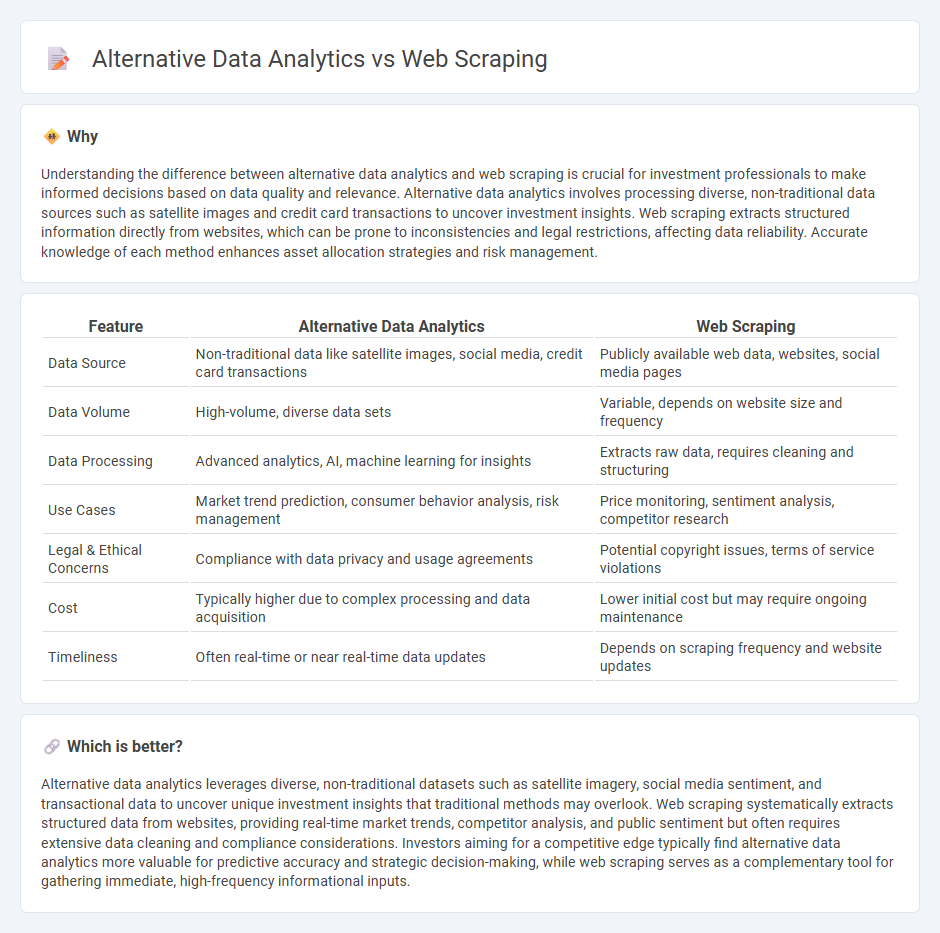
Alternative data analytics leverages diverse, non-traditional data sources such as satellite images, social media trends, and sensor data to derive insights for investment decisions. Web scraping systematically extracts structured information from websites, enabling investors to capture real-time market sentiment, competitor pricing, and consumer behavior. Explore how these innovative techniques revolutionize investment strategies and enhance portfolio performance.
Why it is important
Understanding the difference between alternative data analytics and web scraping is crucial for investment professionals to make informed decisions based on data quality and relevance. Alternative data analytics involves processing diverse, non-traditional data sources such as satellite images and credit card transactions to uncover investment insights. Web scraping extracts structured information directly from websites, which can be prone to inconsistencies and legal restrictions, affecting data reliability. Accurate knowledge of each method enhances asset allocation strategies and risk management.
Comparison Table
| Feature | Alternative Data Analytics | Web Scraping |
|---|---|---|
| Data Source | Non-traditional data like satellite images, social media, credit card transactions | Publicly available web data, websites, social media pages |
| Data Volume | High-volume, diverse data sets | Variable, depends on website size and frequency |
| Data Processing | Advanced analytics, AI, machine learning for insights | Extracts raw data, requires cleaning and structuring |
| Use Cases | Market trend prediction, consumer behavior analysis, risk management | Price monitoring, sentiment analysis, competitor research |
| Legal & Ethical Concerns | Compliance with data privacy and usage agreements | Potential copyright issues, terms of service violations |
| Cost | Typically higher due to complex processing and data acquisition | Lower initial cost but may require ongoing maintenance |
| Timeliness | Often real-time or near real-time data updates | Depends on scraping frequency and website updates |
Which is better?
Alternative data analytics leverages diverse, non-traditional datasets such as satellite imagery, social media sentiment, and transactional data to uncover unique investment insights that traditional methods may overlook. Web scraping systematically extracts structured data from websites, providing real-time market trends, competitor analysis, and public sentiment but often requires extensive data cleaning and compliance considerations. Investors aiming for a competitive edge typically find alternative data analytics more valuable for predictive accuracy and strategic decision-making, while web scraping serves as a complementary tool for gathering immediate, high-frequency informational inputs.
Connection
Alternative data analytics leverages unconventional data sources such as social media, satellite imagery, and transactional data to provide deeper insights for investment decisions. Web scraping automates the extraction of vast amounts of real-time data from websites, feeding alternative data models with timely, granular information. This integration enhances portfolio management by uncovering hidden market trends and improving predictive accuracy in asset valuation.
Key Terms
Data Extraction
Web scraping involves automated techniques to extract large volumes of structured data from websites, enabling businesses to gather real-time market insights and competitive intelligence. Alternative data analytics leverages diverse non-traditional data sources such as social media feeds, satellite imagery, and IoT sensors to provide deeper contextual understanding beyond surface-level web content. Explore more to discover how these data extraction methods can transform your decision-making process.
Sentiment Analysis
Web scraping enables the extraction of large volumes of textual data from social media, news sites, and forums, crucial for real-time sentiment analysis in financial markets. Alternative data analytics leverages diverse datasets such as satellite imagery, credit card transactions, and web traffic to enhance sentiment models with broader behavioral insights. Explore advanced sentiment analysis techniques to harness the full potential of web scraping and alternative data integration.
Market Signals
Web scraping collects raw data from websites to extract real-time market signals like pricing trends, sentiment analysis, and competitor activities, enabling detailed insights into market behavior. Alternative data analytics integrates various unconventional datasets, such as satellite imagery, social media, and credit card transactions, providing broader market signals that enhance predictive accuracy and strategic decision-making. Explore deeper to understand how these methods revolutionize market intelligence and forecasting.
Source and External Links
Web Scraping - Web scraping is the process of automatically mining data or collecting information from the World Wide Web.
What is Web Scraping and How to Use It? - This article explains web scraping in detail and how it is used to obtain data from websites by converting unstructured data into structured formats.
What is Web Scraping and What is it Used For? - Web scraping refers to the extraction of data from a website, which is then exported into a more useful format like a spreadsheet or API.
 dowidth.com
dowidth.com